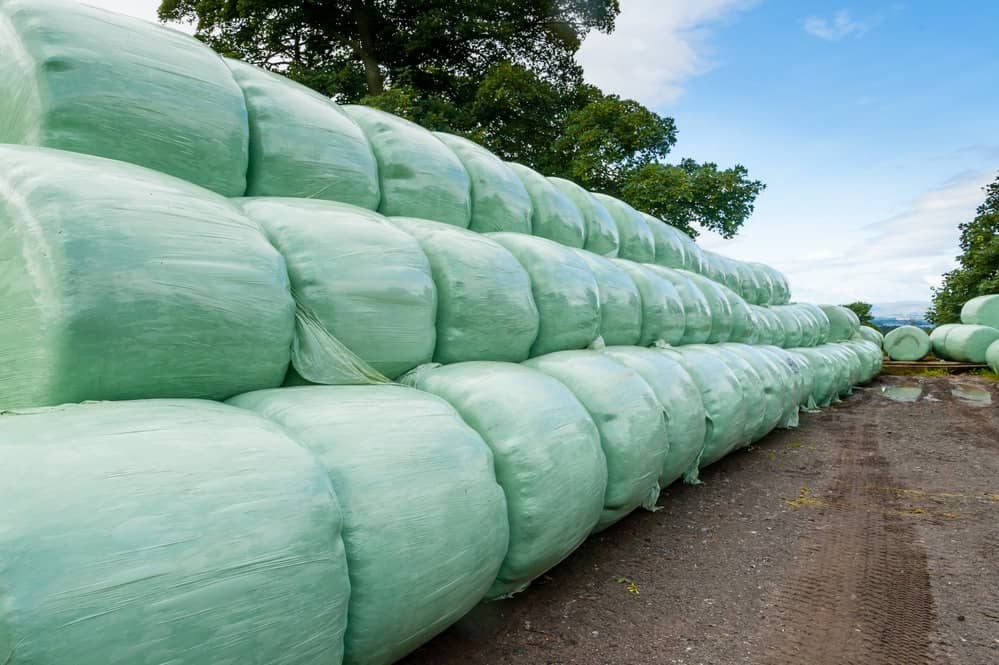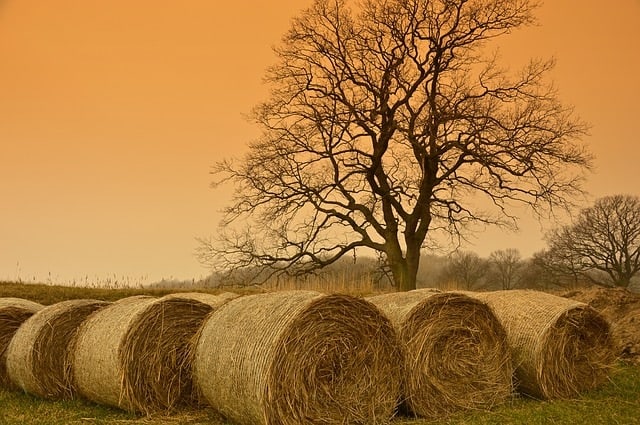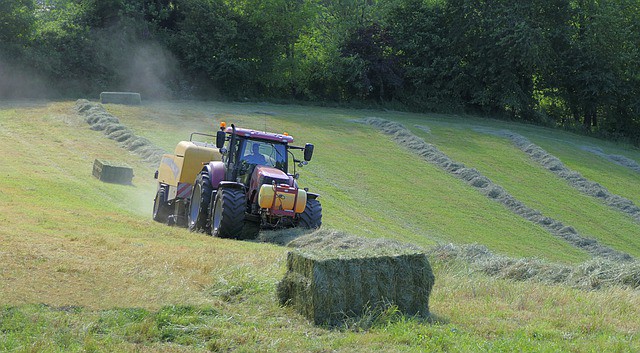Haylage or grass silage is a type of feed made from grass plants that have been chopped into small pieces and pressed together in a storage silo, silage bunker or silage bags. The most commonly used crops are cereals such as maize , but also legumes such as alfalfa . The production process silages adds additional sugars through the natural fermentation process of the plant. The sugar content of fresh grass is only about 5%, but when processed into haylage can contain more than 30%. Haylage has many advantages over hay and straw in bales, including better nutrition and digestibility, and less loss during feeding. Haylage can be fed to all types of livestock. It is particularly popular with dairy cattle due to its high sugar content, which is ideal for increasing milk yield.

What is the difference between haylage and hay?
Haylage hay differs from hay in that it does not lose moisture during the fermentation process. Hay becomes too dry for ensiling if it is not left in the field for more than 1 to 3 days after mowing, depending on weather conditions. Forage harvesting equipment such as a mower, baler or self-propelled forage harvester can be used to mow, rake, pick and bale legumes into plastic haylage film. Oxygen is removed from the bale by sealing the plastic around the silage, allowing aerobic fermentation to take place, resulting in a product that can be stored indefinitely until opened. Fermentation converts sugars into acids (primarily lactic acid), which lowers the pH (acidity) and preserves the crop. The haylage is fermented for up to several weeks before it is harvested into hay bales, making it a more good quality forage . It provides more protein, vitamins and minerals than hay, making it ideal for feeding young animals or lactating animals that need extra nutrients in their diet. Hay also has a much higher calorie content than hay, making it a good option for animals that need weight gain.
Haylage - advantages and disadvantages.
One of the big advantages of haylage is that it has a longer storage life than hay, because a layered film. This means you can store it for longer periods without losing the nutrients and minerals it contains, which are important for the health of your livestock. Haylage can be made from any grass crop, but farmers must remember that for successful preservation, the grass must contain sufficient natural sugars at harvest - which may not be the case with poor quality or drought-affected grassland. Another advantage of haylage is that it contains less dust and dirt, which means that the yield of the product is higher. Less equipment is needed for harvesting and handling. In addition, the quality of the forage is more stable than with hay and the storage life is about one year if the bale has been properly preserved.
Why do you need haylage film?
Fodder is mainly used to feed the animals in winter. In addition to feeding the animals in winter haylage film can also be used for other purposes. If you want to store food for a long time without being affected by sunlight or other factors, you could consider using haylage film. The haylage film can prevent air from entering, so rainwater cannot evaporate and this will keep the food fresh. It also protects against ultraviolet radiation on food. In addition, it can also prevent mould growth and keep food dry. Therefore, you can confidently use this product. Foil for haylage is more convenient than traditional fodder and does not need to be laid by hand at all. Just use the machine to wrap the film.

What to look out for when using haylage film?
Silage wrapping film is a type of packaging material that is widely used in the preservation of fresh fodder, cereals, potatoes and other crops. The quality of silage film directly affects the quality and yield of agricultural products. So what to look out for when using film?
- The ambient temperature plays a decisive role in the effect of silage film. The lower the temperature, the better the effect.
- The surface of the film should be clean and free of foreign matter. The film production plant guarantees high resistance and cleanliness, however the roll is made of plastic material designed for harsh conditions and this bale should be checked.
- Silage film should be stored in a dry and well-ventilated place to avoid prolonged exposure to sunlight, high temperatures and strong acids or alkalis,
- Before covering with silage film, check the product - that there are no holes or broken parts. Silage film is highly resistant, but it is essential to make sure that everything has gone according to plan during production.
- Film thickness varies according to different applications, but in general, thicker films can be used for longer periods. However, this does not mean that thicker ones are better than thinner films. It depends on whether they are adapted to the actual needs; Generally, thinner films can be used for a shorter time due to their low
What haylage film is made of and how it is produced
Film production plant looks similar to those making plastic bags, but with one key difference. The product is produced by extrusion blow moulding. The raw material that the film plant uses is high density polyethylene (HDPE). HDPE granules are placed in a hopper and then sent through a pipe to the extruder. In this process, the plastic is heated until it melts and pressurised air is forced through the opening, causing it to cool and expand like a balloon. As the extrusion process does not require cutting, it is possible to produce continuous rolls of film of virtually any width and length.

We recommend high quality film for haylage agrowrap which is in our offer. Its main advantages are:
- resistant to humidity, UV radiation and temperature changes
- the film will perform under difficult conditions - resistant to snow and frost
- agrowrap products are designed for outdoor use - will not tear in the wind
- resistance to mechanical damage
- wide range of applications for bales
- foil available in white
- is durable and strong - puncture resistant
Foil for haylage is an essential accessory for every farmer. It is designed for small to very large farms. Foil for haylage is available in various sizes. Depending on what the user needs. They are characterized by low weight and high strength, which allows for repeated use during the season.
Productivity and efficiency
Agriculture is a demanding task that requires a lot of hard work and dedication. But it can also pay off, especially when all the farming tasks are done simultaneously. As the demand for high quality, high yielding forage crops continues to grow, improved technology is needed so farmers can keep up. When it comes to harvesting and storage , the new plastic film has been proven to increase productivity even more than ever before and is puncture resistant.
Importance and properties of products of a colour other than white
Quality is affected by colour, as different colours reflect different amounts of light. The ideal colour depends on where you store the bales. Colour foil has a higher UV filter, so that the lifetime can be extended. Therefore, the film has a special additive and UV filters and a thicker outer layer, white as well as coloured film of the best quality is offered. To get your product, all you have to do is use the google search engine with the phrase "haylage twplast".